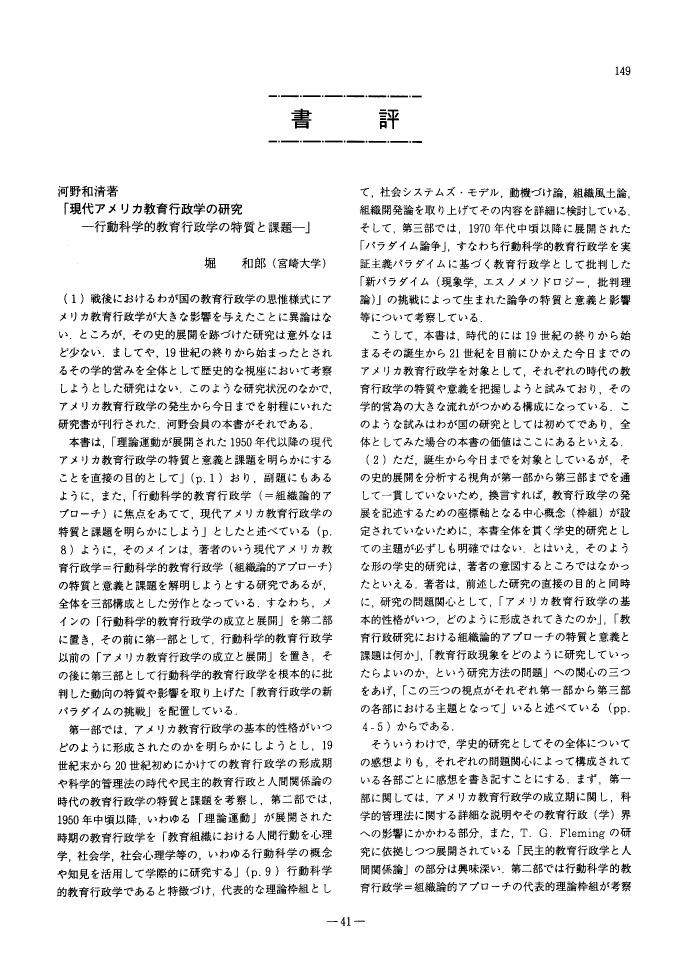4 0 0 0 OA 河野和清著「現代アメリカ教育政学の研究-行動科学的教育行政学の特質と課題-」
- 著者
- 堀 和郎
- 出版者
- 一般社団法人 日本教育学会
- 雑誌
- 教育学研究 (ISSN:03873161)
- 巻号頁・発行日
- vol.63, no.2, pp.149-151, 1996-06-30 (Released:2009-01-13)
2 0 0 0 OA アメリカ教育行政学の再構築 : その背景および経過を中心にして(V 研究報告)
- 著者
- 堀 和郎
- 出版者
- 日本教育行政学会
- 雑誌
- 日本教育行政学会年報 (ISSN:09198393)
- 巻号頁・発行日
- no.19, pp.250-266, 1993-10-09
Educational administration as a field of study in the U.S.A. was reorganized as an empirical social science by the so-called theory movement after World War II. Since then, many conceptual frameworks that this theory movement created provided scholars with theoretical and methodological base for studying educational administration. However, after 1975 circa, many kinds of critiques against the theory movement and its paradigm appeared and educational administration as a discipline is now in the period of academic restructuring. New trends are being formed. It should be said that the study of educational administration is now in the stage of a post-'theory movement'. New trends include newly developed frameworks, such as contingency theory, organized anarchy-garbage can model, institutional 'myth and symbol' approach and educational policy analysis. Qualitative and fieldwork methods are adopted by many researchers. There are seen new academic interests into, the consequences of educational administration on educational practice, value problems, and epistemological issues. In this paper, author tries to make sense of these intellectual trends in the theory and research on educational administration in the U.S.A. Especially, the focus is on their backgrounds and origins, that is, what has been promoted, and who initiated the restructuring of the field and how? As for their backgrounds, it was pointed out that critical consciousness and revisionist thinking were caused among scholars by their recognition of a theory-practice gap in the study of educational administration, which was promoted by challenging developments and turbulent environments surrounding public schools after 1970, such as increasing numbers of underachievers, school vandalism, increasing educational costs, taxpayers' revolt, call for equity school finance policy, public demand for access to school policy making, and demand for school accountability. And under the influence of new study in history of science and philosophy of science that criticized positivism, radical social sciences appeared which began to attack theory and research based on a positivistic concept of science. This trend led to severe critiques against, and critical reassessment of the theory movement paradigm that is basically founded on positivism. Who initiated the restructuring of the field? Was it the Canadian scholar T. Greenfield? Surely, we must not underestimate the importance of his challenge, but, it was self-critical reassessment of its paradigm by leaders of the theory movement themselves that played a leading role in the making of new trends. First of all, critical reassessment had begun before Greenfield's challenge to the theory movement paradigm, though it was sporadic. Secondly, at almost the same time, seminars were held, by scholars who led theory movement, that took a serious look into problems inherent in the theory movement paradigm.
- 著者
- 堀 和郎
- 出版者
- 日本教育政策学会
- 雑誌
- 日本教育政策学会年報
- 巻号頁・発行日
- no.19, pp.196-201, 2012-07-15
- 著者
- 堀 和郎
- 出版者
- 日本教育行政学会
- 雑誌
- 日本教育行政学会年報 (ISSN:09198393)
- 巻号頁・発行日
- no.30, pp.200-204, 2004-10-08
1 0 0 0 大学におけるリカレント教育の推進について
- 著者
- 川野 日郎 原 義彦 上條 秀元 平瀬 清 吉田 甫 草野 勝彦 NAKASONE Rau FINKEL Donal FIKSDAL Susa SMITH Barbar 堀 和郎
- 出版者
- 宮崎大学
- 雑誌
- 国際学術研究
- 巻号頁・発行日
- 1996
本研究グループは、これまで3年にわたって大学におけるリカレント教育(生涯学習)の推進についてアメリカのエヴァグリーン州立大学(TESC)と情報交換・共同研究を行ってきた。本年度は代表者川野と協力者小林がTESCを訪ね研究のまとめを行った。TESCでは州に提出される報告書(Portfolio)をもとに教育や評価について詳細な説明を受けた。TESCの理念は、(1)大学の主目的は教育である,(2)個人学習よりも共同学習、共有学習が優れている,(3)受動的に知識を習得させるのではなく、自ら主体的に学ぶ姿勢(Active learning)を育てる教育を旨とする,(4)専門分野を個別ではなく総合的に関連づけて理解させる,(5)習得した知識は現実に適用されて初めて理解されたと云える,となっている。このような理念の実践のためカリキュラムや評価まで大学全体が組織立てられている。通常の専門教育は行われず全ての授業がそれぞれ一つのプログラムのテーマに沿った構成要素になっている。そして授業内容も徹底した横断的・総合的内容になっている。総合的教育のネックは、学生の成績評価であるが、これについても教官及び学生それぞれの立場からの評価を総合し、極めて綿密で行き届いた論述による評価方式をとっている。こうした大学の教育にかける努力には実に注目に値するものがあった。共同研究では、本来大学の使命は教育と研究であるとするわれわれと種々の点で意見の分かれるところがあったが、TESCは少なくとも教育の面については先進的であり、極めて有用な知見を得ることが出来た。本学の新しい大学教育を考えるとき研究と教育の調和をいかに図るかが大きな課題と考える。生涯学習に関しては、TESCの場合、大学教育そのものが生涯学習の一環であるといえる。大学では専門知識をそのまま直接教えるのではなく、知識の獲得の仕方、使い方を学ぶ、これは将に生涯学習者の育成である。生涯学習の制度的側面など比較研究については、未だ十分な結果は得られていないが、アンケートによる意識調査の結果によると、学生・教官ともに生涯学習に関する意識は高いことがわかった。



